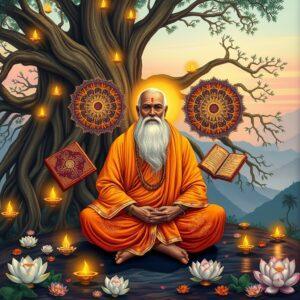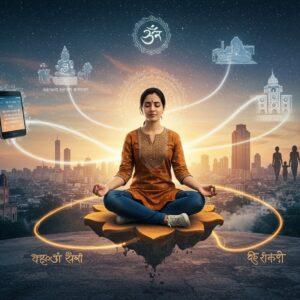
In ancient Indian traditions, the concepts of Anga, Upanga, and Pratyanga hold profound significance. These terms, deeply rooted in disciplines like Ayurveda and Bharatanatyam, offer a nuanced understanding of the human body and its intricate workings. Exploring these concepts not only helps preserve our cultural heritage but also enhances our well-being in the modern world.
Understanding the Core Concepts: Anga, Upanga, and Pratyanga
Anga refers to the primary body parts, forming the foundational structure. Upanga represents the secondary parts, playing supportive roles. Pratyanga denotes the auxiliary parts, further contributing to the body’s complexity. Ancient texts like the Vedas and Upanishads mention these terms, highlighting their importance in various traditional practices. These concepts are crucial in disciplines like Ayurveda and classical dance.
Here’s a breakdown:
- Anga (Primary): Head, Torso, Limbs. These form the major structural components of the body, essential for movement and overall function.
- Upanga (Secondary): Eyes, Ears, Nose. These sensory organs play vital roles in perception and interaction with the world around us.
- Pratyanga (Auxiliary): Shoulders, Thighs, Arms. These connecting parts facilitate movement and provide support to the primary Angas.
Anga and Pratyanga in Ayurveda: A Holistic Approach to Healing
Ayurveda, the ancient Indian system of medicine, utilizes the concepts of Anga and Pratyanga for diagnosis and treatment. By categorizing the body into these components, Ayurvedic practitioners determine Doshas (Vata, Pitta, and Kapha) and their imbalances. Key texts like the Charaka Samhita and Sushruta Samhita detail these elements, providing a framework for holistic healing.
Examples of Anga-based Ayurvedic practices:
- Head massages: To balance Vata dosha and promote mental clarity. This practice involves gentle massage of the head and scalp with specific oils.
- Abdominal treatments: To address Pitta imbalances and improve digestion. This may include herbal remedies and specific dietary recommendations.
- Foot therapies: To balance Kapha dosha and promote grounding. This involves massage and application of herbal pastes to the feet.
Anga, Pratyanga, and Upanga in Bharatanatyam: The Language of Expression
Bharatanatyam, a classical Indian dance form, intricately incorporates Anga, Pratyanga, and Upanga to create expressive movements. The Natya Shastra, an ancient treatise on performing arts, codifies these elements, emphasizing their importance in conveying emotions and narratives through dance.
In Bharatanatyam:
- Anga: Head, Torso, Limbs. These are fundamental for posture, balance, and large movements.
- Pratyanga: Shoulders, Arms, Thighs. They facilitate detailed movements and expressions, adding depth to the dance.
- Upanga: Eyes, Eyebrows, Lips. These are crucial for conveying subtle emotions and facial expressions.
Decoding Anga in Ancient Texts: A Practical Guide
Analyzing references to Anga in ancient texts requires a systematic approach. Linguistic and contextual analysis helps interpret the nuanced meanings of Anga. Recent research explores the genetic connections between ancient populations, including those from the Eurasian Steppe, providing valuable insights into historical migrations and cultural exchanges (refer to studies on ancient DNA and population history, e.g., those published in journals like “Nature”). Further studies explore the relationship between culture, language, and script in the Angika-speaking region using ancient texts and modern perspectives, revealing the complex interplay of these elements in shaping regional identity.
A practical method for understanding Anga in ancient texts involves:
- Identifying key passages: Locate specific mentions of “Anga” within the text. This requires careful reading and analysis of the original language.
- Understanding the context: Analyze the surrounding verses or chapters to grasp the specific meaning of “Anga” in that particular instance.
- Analyzing linguistic patterns: Examine the grammatical structure and word usage to decipher the deeper meaning and significance of “Anga.”
Key texts for further exploration:
- The Vedas: These ancient scriptures offer insights into the ritualistic and philosophical significance of Anga.
- Upanishads: These philosophical texts explore the metaphysical aspects of Anga and its connection to the human body and consciousness.
- Charaka Samhita: This foundational Ayurvedic text provides a detailed understanding of Anga in the context of health and healing.
- Natya Shastra: This ancient treatise on performing arts explains the role of Anga in Bharatanatyam and other classical dance forms.
Embracing Tradition in the Modern World
Anga, Upanga, and Pratyanga continue to influence modern practices in Ayurveda and classical dance, promoting wellness and preserving cultural heritage. The growing interest in these traditions reflects a desire to connect with our roots and embrace holistic well-being.
Poojn.in, India’s leading online store for cultural goods and services, offers a wide range of products to support your journey into these ancient practices. Explore our collection of Ashoka Chal Powder, Arjun Chal Powder, and other authentic Ayurvedic ingredients. You can also find beautiful Pooja Asans to enhance your practice. For those interested in Bharatanatyam, we offer a selection of traditional deities and accessories.
Embrace these timeless practices and integrate them into your life for a more balanced and fulfilling experience.


